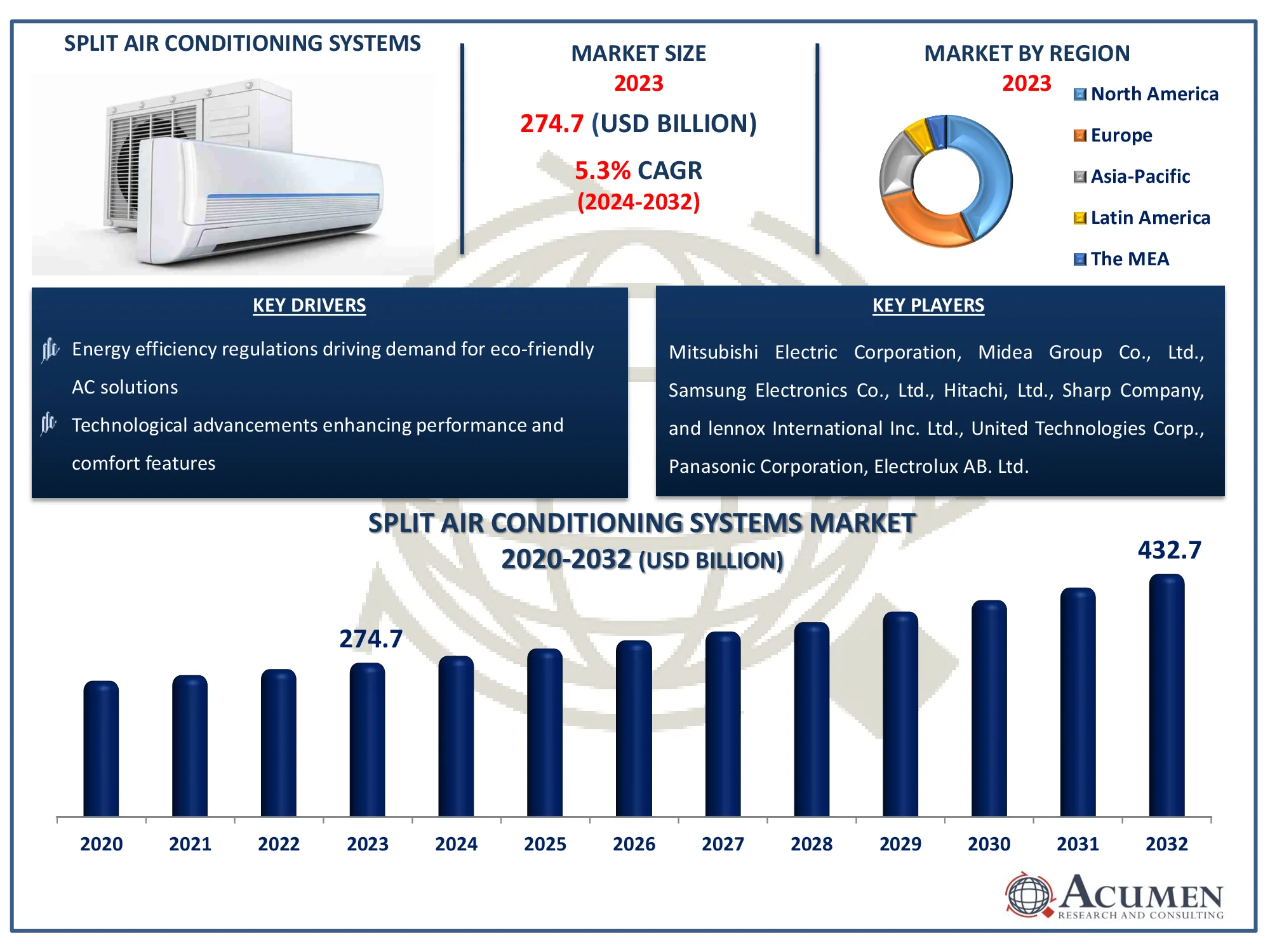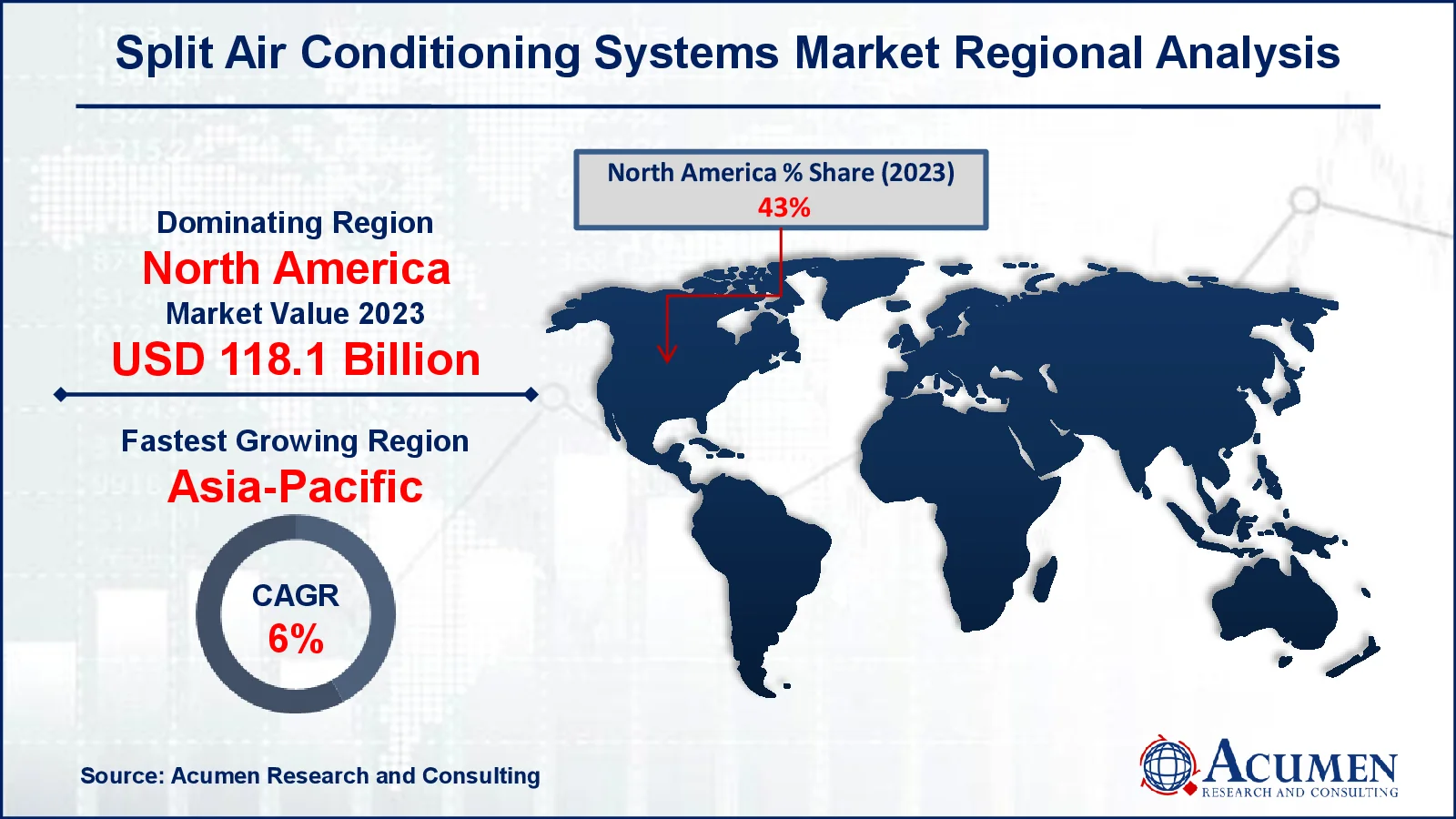Split Air Conditioning Systems Market Size - Global Industry, Share, Analysis, Trends and Forecast 2024 - 2032
Published :
Report ID:
Pages :
Format :
Split Air Conditioning Systems Market Size - Global Industry, Share, Analysis, Trends and Forecast 2024 - 2032
Report Coverage
- Industry Dynamics
- Market Size and Forecast Data
- Segment Analysis
- Competitive Landscape
- Regional Analysis with a Niche Focus on Country-Level Data
- High Level Analysis - Porter's, PESTEL, Value Chain, etc.
- Company Profiles of Key Players
- Option to Customize the Report As Per Your Specific Need
Request Sample Report
The Global Split Air Conditioning Systems Market Size accounted for USD 274.7 Billion in 2023 and is estimated to achieve a market size of USD 432.7 Billion by 2032 growing at a CAGR of 5.3% from 2024 to 2032.
Split Air Conditioning Systems Market Highlights
- Global split air conditioning systems market revenue is poised to garner USD 432.7 billion by 2032 with a CAGR of 5.3% from 2024 to 2032
- North America split air conditioning systems market value occupied around USD 118.1 billion in 2023
- Asia-Pacific split air conditioning systems market growth will record a CAGR of more than 6% from 2024 to 2032
- Among equipment type, the multi split sub-segment generated over US$ 142.9 billion revenue in 2023
- Based on pricing, the low sub-segment generated around 48% split air conditioning systems market share in 2023
- Innovations in cooling technologies catering to specific climate needs is a popular split air conditioning systems market trend that fuels the industry demand

The split air conditioning systems market refers to the industry that manufactures, distributes, and sells heating, ventilation, and air conditioning (HVAC) systems in a split configuration. These systems are made up of two primary components: an indoor unit that distributes cooled or heated air and an outside unit that houses the compressor and condenser. Split air conditioning systems provide effective climate control options for a variety of environments, including homes, businesses, retail spaces, and more. When compared to traditional HVAC systems, their popularity arises from their versatility, energy efficiency, and ease of installation. With technological developments, these systems have grown more adaptable, with features such as zoning for personalized temperature control and eco-friendly refrigerants driving market expansion. The market's growth is being driven by an increasing emphasis on comfort, energy economy, and long-term cooling solutions in a variety of industries.
Global Split Air Conditioning Systems Market Dynamics
Market Drivers
- Growing urbanization and construction boosting installation rates
- Energy efficiency regulations driving demand for eco-friendly AC solutions
- Technological advancements enhancing performance and comfort features
- Increasing consumer awareness of health benefits driving demand for air purification features in systems
Market Restraints
- Volatile raw material costs impacting manufacturing expenses and pricing
- High initial installation costs restricting widespread adoption in some markets
- Environmental concerns over refrigerants' impact on global warming limiting product options
Market Opportunities
- Expansion in smart home technology integration for remote monitoring and control
- Rising demand for energy-efficient systems amid sustainability trends
- Emerging markets presenting untapped growth potential for market penetration
Split Air Conditioning Systems Market Report Coverage
|
Market |
Split Air Conditioning Systems Market |
|
Split Air Conditioning Systems Market Size 2023 |
USD 274.7 Billion |
|
Split Air Conditioning Systems Market Forecast 2032 |
USD 432.7 Billion |
|
Split Air Conditioning Systems Market CAGR During 2024 - 2032 |
5.3% |
|
Split Air Conditioning Systems Market Analysis Period |
2020 - 2032 |
|
Split Air Conditioning Systems Market Base Year |
2023 |
|
Split Air Conditioning Systems Market Forecast Data |
2024 - 2032 |
|
Segments Covered |
By Equipment Type, By Installation, By Pricing, By Capacity, By Application, By Distribution Channel, and By Geography |
|
Regional Scope |
North America, Europe, Asia Pacific, Latin America, and Middle East & Africa |
|
Key Companies Profiled Aviation |
Mitsubishi Electric Corporation, Daikin Industries, Ltd., Midea Group Co., Ltd., Samsung Electronics Co., Ltd., Hitachi, Ltd., Sharp Company, Lennox International Inc., United Technologies Corp., Panasonic Corporation, and Electrolux AB. Ltd. |
|
Report Coverage |
Market Trends, Drivers, Restraints, Competitive Analysis, Player Profiling, Covid-19 Analysis, Regulation Analysis |
Split Air Conditioning Systems Market Insights
The energy efficiency of split air conditioners has increased in recent years as a result of developments in air conditioning technology. Generally, the efficiency of an air conditioning system is measured by the SEER (Seasonal Energy Efficiency Ratio). Since 1990, SEER ratings have increased by 50% and 57% for residential and commercial split air conditioning systems, reaching 4.2 in 2016. Split air conditioners demonstrate higher energy efficiency compared to window units. The countries with the most common air conditioning SEERs include Japan, South Korea, China, USA, Singapore, Canada, Australia, Thailand, Saudi Arabia, India, etc. Energy-efficient split air conditioners are particularly in demand in developed regions like Europe, driven by strict environmental regulations. However, even emerging economies in the Asia-Pacific region are experiencing a growing demand for energy-efficient split air conditioning systems.
The warm climate in India and other Southeast Asian countries, coupled with population growth and increased disposable income, is expected to drive the demand for split air conditioning systems. Consequently, global air conditioning system manufacturers have established production units in India, reducing the cost of split air conditioners. This presents an excellent opportunity for participants in the global split air conditioning system market in India. However, cost remains a challenge. Split air conditioners come in mini-split or multi-split variants. According to the U.S. Energy Department, the primary drawback is the high cost of mini-split air conditioners, ranging from USD 1500 to USD 2000 per ton of cooling capacity. Energy-efficient split air conditioners are more expensive than conventional ones. In China, for instance, the price of energy-efficient split air conditioning is generally twice that of conventional units, with an average payback period of 10 years. As a result, the cost of split air conditioners, along with increased energy consumption, continues to rise.
Split Air Conditioning Systems Market Segmentation
The worldwide market for split air conditioning systems is split based on equipment type, installation, pricing, capacity, application, distribution channel, and geography.
Split Air Conditioning System Market By Equipment Type
Multi Split
- Mini Split
- VRF
- Floor Ceiling
According to split air conditioning systems industry analysis, the multi-split sector holds a prominent position in the market due to its adaptability and cost-effectiveness. Multi-split systems seamlessly connect a single outdoor unit to multiple indoor units, delivering adjustable climate control for diverse zones within a building. This capability to efficiently cool several rooms or spaces with varying temperature needs, without necessitating separate exterior units, resonates with both residential and commercial customers. Moreover, the cost-efficient installation and maintenance, compared to individual units, make multi-split systems a popular choice, further cementing their leadership in the market.
Split Air Conditioning System Market By Installation
- Wall Mounted
- Freestanding
The wall-mounted segment continues to spearhead the split air conditioning systems market. Its widespread appeal stems from its space-efficient design and aesthetic integration, catering adeptly to residential and commercial needs. These units, occupying minimal space while offering efficient cooling, align well with interior aesthetics. With an easy installation process and adaptable features, the wall-mounted segment is expected to maintain its lead during market forecast period, meeting diverse consumer preferences and driving sustained growth.
Split Air Conditioning System Market By Pricing
- Low
- Medium
- High
Split air conditioning systems industry analysis underscores the dominance of the low-cost category in the split air conditioning systems market. This segment addresses the needs of budget-conscious consumers by providing accessible entry-level cooling solutions at competitive prices. Its user-friendly nature and appeal to price-sensitive customers continue to drive its market domination, establishing it as the preferred choice for individuals seeking fundamental functionality without exceeding their budget constraints.
Split Air Conditioning System Market By Capacity
- Less than 1 Ton
- 1 Ton to 1.5 Ton
- 1.5 Ton to 2.0 Ton
- More than 2.0 Ton
The 1 Ton to 1.5 Ton sub-segment continues to dominate throughtout the market forecast period in the split air conditioning systems market due to its adaptability and widespread suitability for residential and small commercial spaces. This capacity range adeptly meets typical cooling needs while striking a balance between efficiency and coverage. Its appeal to a broad user base seeking optimal performance without excessive power consumption or over-sizing for smaller rooms is anticipated to sustain its market leadership.
Split Air Conditioning System Market By Application
- Residential
- Commercial
The residential application sub-segment holds the highest part of the split air conditioning systems market, owing to its widespread usage in homes. Its appeal is in delivering personalized comfort, answering specific cooling demands for families. This segment provides compact solutions, energy efficiency, and quiet operation, perfectly fitting with the cozy ambiance wanted in residential settings and strengthening its market leadership.
Split Air Conditioning System Market By Distribution Channel
- Offline
- Online
The offline distribution channel has the biggest market share in the split air conditioning systems industry, owing to its personalized client experience. This channel allows clients to physically interact with products, obtain professional information, and receive immediate assistance, creating trust and satisfaction. The hands-on approach, along with specialized service and rapid solutions, produces a tangible and reassuring buying experience, consolidating its market supremacy.
Split Air Conditioning Systems Market Regional Outlook
North America
- U.S.
- Canada
Europe
- U.K.
- Germany
- France
- Spain
- Rest of Europe
Asia-Pacific
- India
- Japan
- China
- Australia
- South Korea
- Rest of Asia-Pacific
Latin America
- Brazil
- Mexico
- Rest of LATAM
The Middle East & Africa
- South Africa
- GCC Countries
- Rest of the Middle East & Africa (ME&A)

Split Air Conditioning Systems Market Regional Analysis
North America is the largest region in the split air conditioning systems market, owing to significant infrastructural development and a high level of life. Its dominance is based on technology developments, high energy efficiency standards, and a strong customer preference for smart and environmentally friendly solutions. Meanwhile, because to rapid urbanization, rising temperatures, and an expanding middle class, the Asia-Pacific region emerges as the fastest-growing market. Rising disposable incomes, more climate control awareness, and increased construction activity are driving the region's demand surge. Furthermore, government programs supporting the implementation of sustainable technologies in this area enhance the adoption of split AC systems, accelerating Asia-Pacific's spectacular growth trajectory in the global market.
Europe stands as the second-largest divisional market globally for air conditioning systems. Within Europe, the market is predominantly led by split air conditioners, with mini-split systems playing a significant role. Russia emerges as the largest market for split air conditioning systems in Europe. Additionally, France, Spain, Italy, and the United Kingdom are major markets for split air conditioners in the region. The increased demand for relatively expensive Variable Refrigerant Flow (VRF) air conditioners, compared to other types of split systems, contributes to the growth of Europe's split system market.
Split Air Conditioning Systems Market Players
Some of the top split air conditioning systems companies offered in our report includes Mitsubishi Electric Corporation, Daikin Industries, Ltd., Midea Group Co., Ltd., Samsung Electronics Co., Ltd., Hitachi, Ltd., Sharp Company, Lennox International Inc., United Technologies Corp., Panasonic Corporation, Electrolux AB. Ltd.
Frequently Asked Questions
How big is the split air conditioning systems market?
The market size of split air conditioning systems was USD 274.7 billion in 2023.
What is the CAGR of the global split air conditioning systems market from 2024 to 2032?
The CAGR of split air conditioning systems is 5.3% during the analysis period of 2024 to 2032.
Which are the key players in the split air conditioning systems market?
The key players operating in the global market are including Mitsubishi Electric Corporation, Daikin Industries, Ltd., Midea Group Co., Ltd., Samsung Electronics Co., Ltd., Hitachi, Ltd., Sharp Company, Lennox International Inc., United Technologies Corp., Panasonic Corporation, and Electrolux AB. Ltd.
Which region dominated the global split air conditioning systems market share?
North America held the dominating position in split air conditioning systems industry during the analysis period of 2024 to 2032.
Which region registered fastest CAGR from 2024 to 2032?
Asia-Pacific region exhibited fastest growing CAGR for market of split air conditioning systems during the analysis period of 2024 to 2032.
What are the current trends and dynamics in the global split air conditioning systems industry?
The current trends and dynamics in the split air conditioning systems industry include energy efficiency regulations driving demand for eco-friendly AC solutions, technological advancements enhancing performance and comfort features, growing urbanization and construction boosting installation rates, and increasing consumer awareness of health benefits driving demand for air purification features in systems.
Which equipment type held the maximum share in 2023?
The multi split equipment type held the maximum share of the split air conditioning systems industry.?



